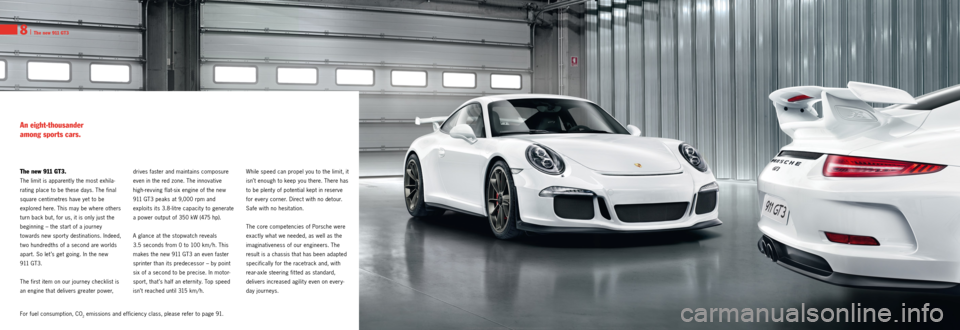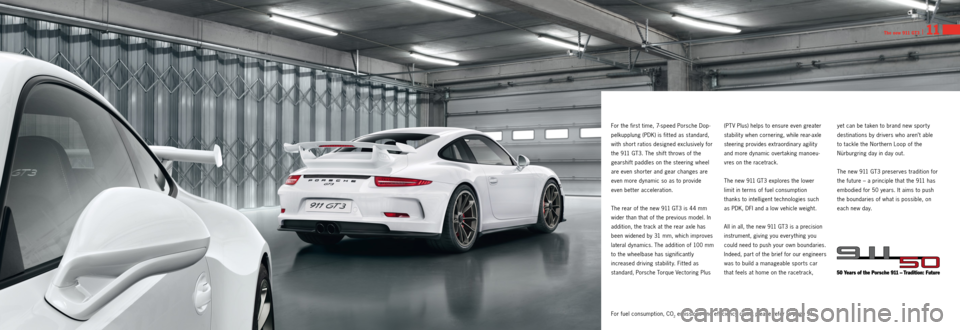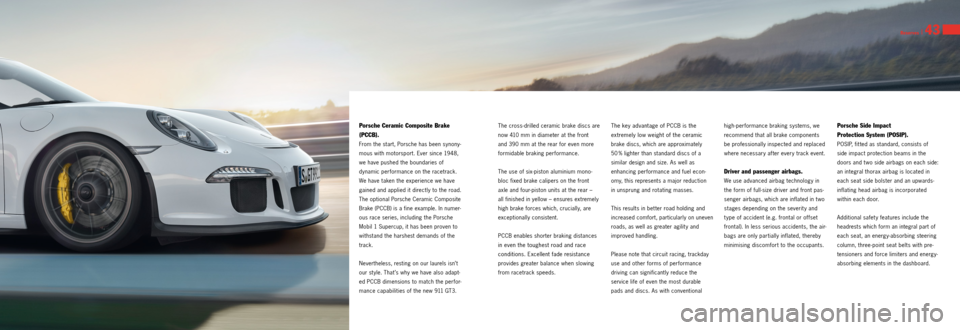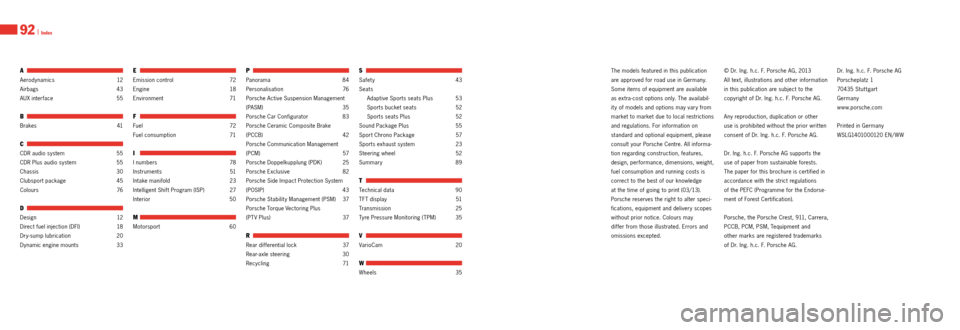fuel reserve PORSCHE 911 GT3 2013 6.G Information Manual
[x] Cancel search | Manufacturer: PORSCHE, Model Year: 2013, Model line: 911 GT3, Model: PORSCHE 911 GT3 2013 6.GPages: 49, PDF Size: 22.75 MB
Page 5 of 49

8 I The new 911 GT3
The new 911 GT3.
The limit is apparently the most exhila
rating place to be these days. The final
square centimetres have yet to be
explored here. This may be where others
turn back but, for us, it is only just the
beginning – the start of a journey
towards new sport y destinations. Indeed,
t wo hundredths of a second are worlds
apart. So let ’s get going. In the new
9 11 G T 3 .
The first item on our journey checklist is
an engine that delivers greater power,
An eight-thousander
among sports cars.
drives faster and maintains composure
even in the red zone. The innovative
high revving flat six engine of the new
911 GT3 peaks at 9,000 rpm and
exploits its 3.8 litre capacit y to generate
a power output of 350 kW (475 hp).
A glance at the stopwatch reveals
3.5 seconds from 0 to 100 km/ h. This
makes the new 911 GT3 an even faster
sprinter than its predecessor – by point
six of a second to be precise. In motor
sport, that ’s half an eternit y. Top speed
isn’t reached until 315 km/ h. While speed can propel you to the limit, it
isn’t enough to keep you there. There has
to be plent y of potential kept in reserve
for every corner. Direct with no detour.
Safe with no hesitation.
The core competencies of Porsche were
exactly what we needed, as well as the
imaginativeness of our engineers. The
result is a chassis that has been adapted
specifically for the racetrack and, with
rear
axle steering fit ted as standard,
delivers increased agilit y even on every
day journeys.
For fuel consumption, CO
2 emissions and efficiency class, please refer to page 91.
Page 6 of 49

The new 911 GT3 I 11
For the first time, 7speed Porsche Dop
pelkupplung (PDK) is fit ted as standard,
with short ratios designed exclusively for
the 911 GT3. The shift throws of the
gearshift paddles on the steering wheel
are even shorter and gear changes are
even more dynamic so as to provide
even better acceleration.
The rear of the new 911 GT3 is 44 mm
wider than that of the previous model. In
addition, the track at the rear axle has
been widened by 31 mm, which improves
lateral dynamics. The addition of 100 mm
to the wheelbase has significantly
increased driving stabilit y. Fit ted as
standard, Porsche Torque Vectoring Plus (PT V Plus) helps to ensure even greater
stability when cornering, while rear
axle
steering provides extraordinar y agilit y
and more dynamic overtaking manoeu
vres on the racetrack.
The new 911 GT3 explores the lower
limit in terms of fuel consumption
thanks to intelligent technologies such
as PDK, DFI and a low vehicle weight.
All in all, the new 911 GT3 is a precision
instrument, giving you everything you
could need to push your own boundaries.
Indeed, part of the brief for our engineers
was to build a manageable sports car
that feels at home on the racetrack, yet can be taken to brand new sport y
destinations by drivers who aren’t able
to tackle the Northern Loop of the
Nürburgring day in day out.
The new 911 GT3 preserves tradition for
the future – a principle that the 911 has
embodied for 50 years. It aims to push
the boundaries of what is possible, on
each new day.
For fuel consumption, CO
2 emissions and efficiency class, please refer to page 91.
Page 22 of 49

Reserves I 43
Porsche Ceramic Composite Brake
(PCCB).
From the start, Porsche has been synony
mous with motorsport. Ever since 1948,
we have pushed the boundaries of
dynamic performance on the racetrack.
We have taken the experience we have
gained and applied it directly to the road.
The optional Porsche Ceramic Composite
Brake (PCCB) is a fine example. In numer
ous race series, including the Porsche
Mobil 1 Supercup, it has been proven to
withstand the harshest demands of the
track.
Nevertheless, resting on our laurels isn’t
our st yle. That ’s why we have also adapt
ed PCCB dimensions to match the perfor
mance capabilities of the new 911 GT3. The cross
drilled ceramic brake discs are
now 410 mm in diameter at the front
and 390 mm at the rear for even more
formidable braking performance.
The use of six piston aluminium mono
bloc fixed brake calipers on the front
axle and four piston units at the rear –
all finished in yellow – ensures extremely
high brake forces which, crucially, are
exceptionally consistent.
PCCB enables shorter braking distances
in even the toughest road and race
conditions. Excellent fade resistance
provides greater balance when slowing
from racetrack speeds.
The key advantage of PCCB is the
extremely low weight of the ceramic
brake discs, which are approximately
50 % lighter than standard discs of a
similar design and size. As well as
enhancing performance and fuel econ
omy, this represents a major reduction
in unsprung and rotating masses.
This results in bet ter road holding and
increased comfort, particularly on uneven
roads, as well as greater agilit y and
improved handling.
Please note that circuit racing, trackday
use and other forms of performance
driving can significantly reduce the
service life of even the most durable
pads and discs. As with conventional high
performance braking systems, we
recommend that all brake components
be professionally inspected and replaced
where necessary after every track event.
Driver and passenger airbags.
We use advanced airbag technology in
the form of full size driver and front pas
senger airbags, which are inflated in t wo
stages depending on the severit y and
t ype of accident (e.g. frontal or offset
frontal). In less serious accidents, the air
bags are only partially inflated, thereby
minimising discomfort to the occupants.
Porsche Side Impact
Protection System (POSIP).
POSIP, fit ted as standard, consists of
side impact protection beams in the
doors and t wo side airbags on each side:
an integral thorax airbag is located in
each seat side bolster and an upwards
inflating head airbag is incorporated
within each door.
Additional safety features include the
headrests which form an integral part of
each seat, an energy absorbing steering
column, three point seat belts with pre
tensioners and force limiters and energy
absorbing elements in the dashboard.
Page 47 of 49

92 I Index
A
A e r o d y n a m ic s 12
Airbags 43
AUX inter face 55
B
B ra k es 41
C
CDR audio system 55
CDR Plus audio system 55
Chassis 30
Clubsport package 45
Colours 76
D
Design 12
Direct fuel injection (DFI) 18
Dry sump lubrication 20
Dynamic engine mounts 33
E
Emission control 72
Engine 18
Environment 71
F
Fuel 72
Fuel consumption 71
I
I numbers 78
Instruments 51
Intake manifold 23
Intelligent Shift Program (ISP) 27
Interior 50
M
Motorsport 60
P
Panorama 84
Personalisation 76
Porsche Active Suspension Management
(PASM) 35
Porsche Car Configurator 83
Porsche Ceramic Composite Brake
(PCCB) 42
Porsche Communication Management
(P CM) 57
Porsche Doppelkupplung (PDK) 25
Porsche Exclusive 82
Porsche Side Impact Protection System
(POSIP) 43
Porsche Stabilit y Management (PSM) 37
Porsche Torque Vectoring Plus
(PT V Plus) 37
R
Rear differential lock 37
Rear axle steering 30
Recycling 71
S
Safet y 43
Seats
Adaptive Sports seats Plus 53
Sports bucket seats 52
Sports seats Plus 52
Sound Package Plus 55
Sport Chrono Package 57
Sports exhaust system 23
Steering wheel 52
Summary 89
T
Technical data 90
TFT display 51
Tra n s m i s si o n 25
Tyre Pressure Monitoring (TPM) 35
V
VarioCam 20
W
Wheels 35 The models featured in this publication
are approved for road use in Germany.
Some items of equipment are available
as extra
cost options only. The availabil
it y of models and options may vary from
market to market due to local restrictions
and regulations. For information on
standard and optional equipment, please
consult your Porsche Centre. All informa
tion regarding construction, features,
design, performance, dimensions, weight,
fuel consumption and running costs is
correct to the best of our knowledge
at the time of going to print (03/13).
Porsche reserves the right to alter speci
fications, equipment and deliver y scopes
without prior notice. Colours may
differ from those illustrated. Errors and
omissions excepted. © Dr. Ing. h.c. F. Porsche AG, 2013
All text, illustrations and other information
in this publication are subject to the
copyright of Dr. Ing. h.c. F. Porsche AG.
Any reproduction, duplication or other
use is prohibited without the prior written
consent of Dr. Ing. h.c. F. Porsche AG.
Dr. Ing. h.c. F. Porsche AG supports the
use of paper from sustainable forests.
The paper for this brochure is certified in
accordance with the strict regulations
of the PEFC (Programme for the Endorse
ment of Forest Certification).
Porsche, the Porsche Crest, 911, Carrera,
PCCB, PCM, PSM, Teq u ip m ent a nd
other marks are registered trademarks
of
Dr. Ing. h.c. F. Porsche AG. Dr. Ing. h.c. F. Porsche AG
Porscheplatz 1
70435 Stut tgart
Germany
www.porsche.com
Printed in Germany
WSLG1401000120 EN/ WW